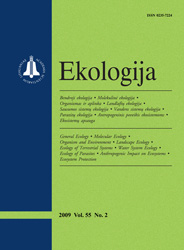 ISSN 0235-7224 ISSN 2029-0586 (online) |
2009 m. Nr. 2 Ecotoxicological assessment of arable field
soils fertilized with sewage sludge
The majority of cities have sewage treatment equipment where sludge is accumulated. The use of sludge is problematic even now, under a rapid development of different technologies, and this issue is the object of numerous discussions. Sewage sludge can be used for fertilizing soil, as it is an organic substance containing many biotic substances. However, the use of sewage sludge for fertilizing fields is limited by several factors such as high levels of heavy metals, pathogenic microorganisms and an unpleasant smell. Therefore, the use of this organic fertilizer is regulated by different normative acts. The study was carried out in 1993–2008 in Vilnius District in arenosols (Pakenė, Skurbutėnai, Merešlėnai). The soils of intensively arable fields, especially in poor sandy soils, require special attention while analysing their biological processes related to mineralization and humification. Taking into account the complexity of the mechanism of the processes taking place in the soil, ecotoxicological methods based on biotesting are used for establishing the ecological state of soil. Pedobionts – organisms constantly living in the soil – are used for this purpose. A single fertilization of arable field loam sandy soils with 8 to 20 t · ha–1 of sewage sludge significantly improves the agrochemical qualities of the soil, does not contaminate it with heavy metals, and the crop grown on it is clean. Improvement of agrochemical and biological qualities of the arenosol of arable fields is observed only after repeated fertilization of these soils with sewage sludge (20 t · ha–1 in the fifth year). Then the amount of humus in them increases by 1.8 to 2.6%. The reaction of the soil becomes neutral. Biological processes become more active. The results of the research show that the crops grown on arenosols fertilized with sewage sludge is little contaminated with heavy metals and do not exceed the levels allowed for forage crops. Keywords: soil, arable fields, sewage sludge, heavy metals, microarthropods |
Issues:
2011 - Vol.57 No. 1, No. 2 2010 - Vol.56 No. 1-2, No. 3-4 2009 - Vol.55 No. 1, No. 2, No. 3-4 2008 - Vol.54 No. 1, No. 2, No. 3, No. 4 2007 - Vol.53 No. 1, No. 2, No. 2.priedas, No. 3, No. 4 2006 No. 1, No. 2, No. 3, No. 4 2005 No. 1, No. 2, No. 3, No. 4 2004 No. 1, No. 2, No. 3, No. 4 2003 No. 1, No. 2, No. 3, No. 4 2002 No. 1, No. 2, No. 3, No. 4 2001 No. 1, No. 2, No. 3, No. 4 |